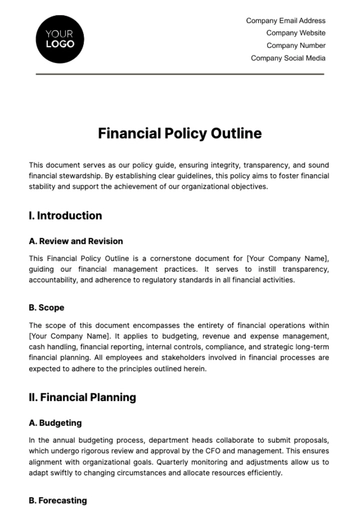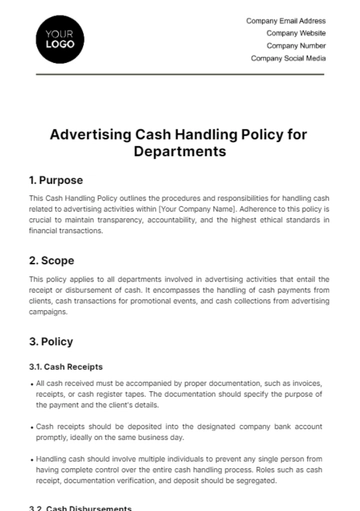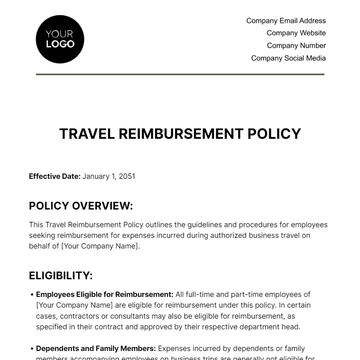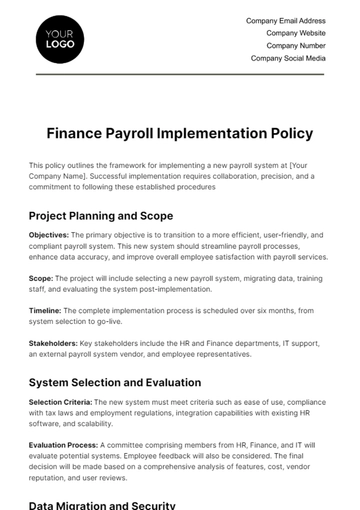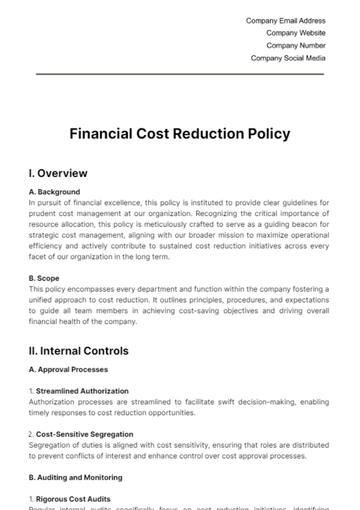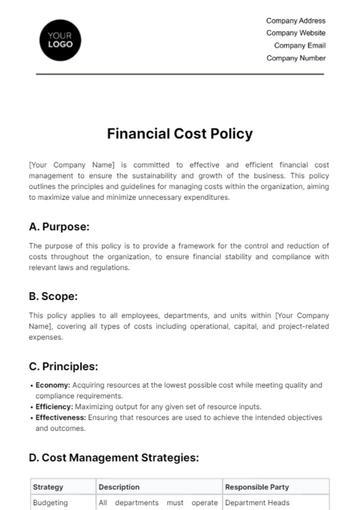Free Financial Cost Reduction Policy
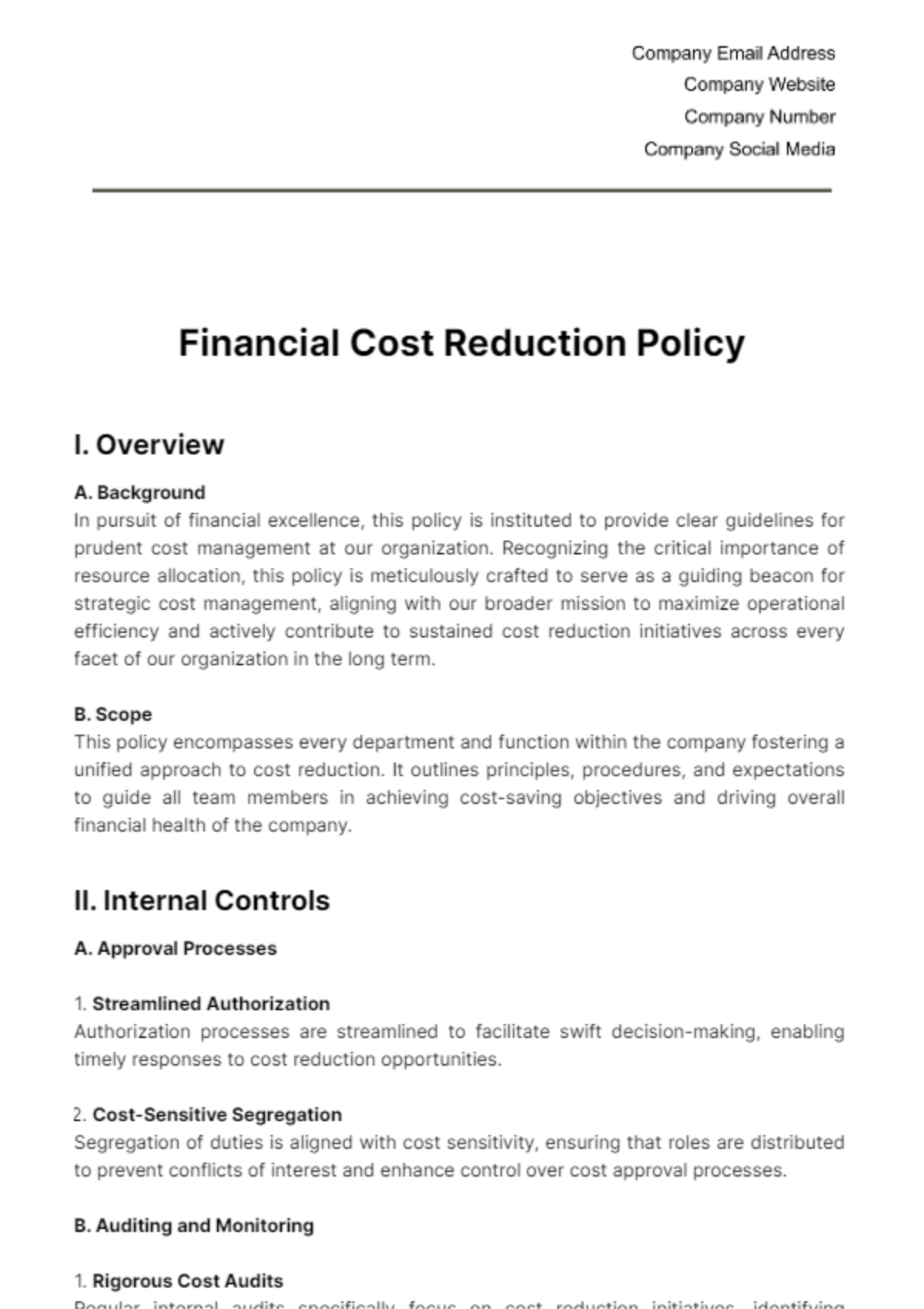
I. Overview
A. Background
In pursuit of financial excellence, this policy is instituted to provide clear guidelines for prudent cost management at our organization. Recognizing the critical importance of resource allocation, this policy is meticulously crafted to serve as a guiding beacon for strategic cost management, aligning with our broader mission to maximize operational efficiency and actively contribute to sustained cost reduction initiatives across every facet of our organization in the long term.
B. Scope
This policy encompasses every department and function within the company fostering a unified approach to cost reduction. It outlines principles, procedures, and expectations to guide all team members in achieving cost-saving objectives and driving overall financial health of the company.
II. Internal Controls
A. Approval Processes
Streamlined Authorization
Authorization processes are streamlined to facilitate swift decision-making, enabling timely responses to cost reduction opportunities.
Cost-Sensitive Segregation
Segregation of duties is aligned with cost sensitivity, ensuring that roles are distributed to prevent conflicts of interest and enhance control over cost approval processes.
B. Auditing and Monitoring
Rigorous Cost Audits
Regular internal audits specifically focus on cost reduction initiatives, identifying inefficiencies, and ensuring adherence to cost reduction guidelines.
Real-Time Monitoring
Real-time monitoring mechanisms are implemented to track expenditures, enabling proactive management of cost-related activities and ensuring ongoing alignment with cost reduction.
III. Information Systems Integration
A. Technological Synergy
Integration for Efficiency
Information systems are seamlessly integrated to enhance efficiency in cost tracking, allowing for real-time insights into expenditures and supporting effective cost reduction strategies.
Advanced Analytics Adoption
Adoption of advanced analytics technologies supports data-driven decision-making, aiding in the identification of cost reduction opportunities and trends.
B. Data Security and Confidentiality
Enhanced Data Security
Rigorous data protection measures are in place to safeguard cost-related information, ensuring confidentiality and compliance with privacy regulations.
Regulatory Compliance
Compliance with data protection regulations is prioritized to maintain the integrity and security of cost-related data.
IV. Incremental Cost Analysis
A. Strategic Decision-Making
Impact Assessment
Incremental cost analysis is integral to strategic decision-making, assessing the impact of choices on overall costs and aligning decisions with cost reduction objectives.
Long-Term Cost Considerations
Decisions are evaluated for their long-term cost implications, ensuring that short-term cost reductions contribute to sustained financial health.
B. Cross-Functional Collaboration
Holistic Cost Perspectives
Cross-functional collaboration is encouraged for a holistic understanding of cost implications, promoting collective efforts towards effective cost reduction.
Continuous Improvement Culture
A culture of continuous improvement is fostered, ensuring that feedback loops contribute to ongoing refinement of cost reduction strategies.
V. Incentive Structures
A. Performance-Linked Incentives
Cost Reduction Metrics
Incentive structures are directly linked to cost reduction metrics, motivating employees at all levels to actively participate in and contribute to cost reduction initiatives.
Fair Criteria
Transparent and fair criteria for earning incentives are established, ensuring that incentives are earned through measurable contributions to cost reduction goals.
B. Recognition of Innovation
Incentives also recognize innovative solutions that contribute to cost reduction. Employees proposing and implementing creative ideas are acknowledged for their role in driving efficient cost practices.
VI. Inventory Management
A. Efficient Inventory Practices
Lean Inventory Strategies
Inventory management policies prioritize lean strategies, minimizing carrying costs and reducing waste through efficient stock level maintenance.
Demand-Driven Approaches
Inventory decisions are driven by demand forecasts, ensuring that stock levels align with market requirements and support cost-effective inventory management.
B. Technology Integration
Automation for Accuracy
Automated tracking systems are integrated to enhance inventory accuracy, reducing errors and supporting cost-effective inventory control.
Real-Time Monitoring
Real-time monitoring of inventory levels allows for immediate adjustments to market demands, minimizing holding costs and ensuring timely response to inventory needs.
VII. Inclusive Cost Analysis
A. Comprehensive Decision Support
Holistic Cost Considerations
Inclusive cost analysis considers both direct and indirect costs, providing a comprehensive view of decision impacts on the organization's financial health.
Strategic Financial Planning
Decisions are evaluated not only for immediate cost implications but also for their alignment with strategic financial planning, contributing to sustained cost-effectiveness.
B. Stakeholder Involvement
Collaborative Decision-Making
Stakeholder involvement is integral to inclusive cost analysis, ensuring that decisions align with broader organizational goals and receive input from relevant stakeholders.
Transparent Decision Processes
Transparency is maintained in the analysis process, allowing stakeholders to understand decision-making methodologies and fostering trust in cost-related choices.
VIII. Implementation Guidelines
A. Communication Strategy
Transparent Communication
Transparent communication channels are utilized to disseminate cost reduction strategies across the organization, ensuring clarity and understanding of the implementation guidelines.
Training for Alignment
Comprehensive training programs are conducted to align employees with the cost reduction strategies, empowering them with the knowledge and skills necessary for effective implementation.
B. Change Management Processes
Change Readiness Assessments
Change readiness assessments are conducted to gauge organizational preparedness for cost reduction initiatives, allowing for proactive change management strategies.
Feedback-Driven Improvements
Feedback loops during the implementation phase allow for continuous improvement, incorporating insights from employees to refine and optimize cost reduction practices.
IX. Review and Revision
A. Periodic Evaluations
The cost reduction policy undergoes scheduled assessments to evaluate its effectiveness, relevance, and alignment with the organization's evolving goals.
B. Incorporation of Stakeholder Feedback
Stakeholder feedback is systematically incorporated into the review process, ensuring that the cost reduction policy remains adaptive and responsive to the needs of the organization.
- 100% Customizable, free editor
- Access 1 Million+ Templates, photo’s & graphics
- Download or share as a template
- Click and replace photos, graphics, text, backgrounds
- Resize, crop, AI write & more
- Access advanced editor
Redefine cost management with the Financial Cost Reduction Policy Template from Template.net! Explore its advanced features using the intuitive AI Editor Tool, transforming it into a customizable solution. Craft policies that adapt to your needs, ensuring a proactive approach to cost reduction. Shape your financial efficiency with this editable template!
You may also like
- HR Policy
- Restaurant Policy
- Company Policy
- Accounting Policies and Procedures
- Website Policy
- Privacy Policy
- Safety Policy
- School Policy
- IT and Software Policy
- Law Firm Policy
- Construction Policy
- Interior Design Policy
- Travel Agency Policy
- Education Academic Policy
- Security Policy
- Real Estate Policy
- Expense Policy
- Software Policy



